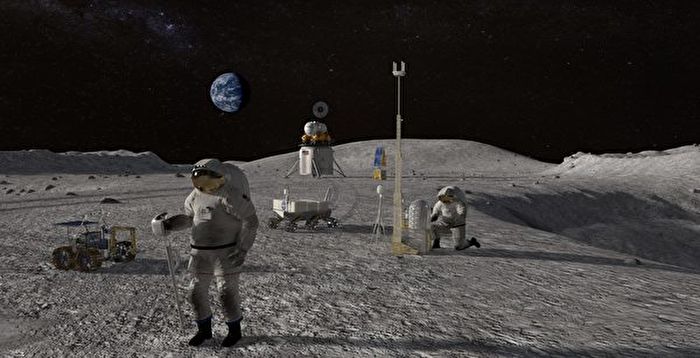[Epoch Times, May 25, 2022](The Epoch Times reporter Di Rui compiled and reported) A new study suggests that the moon has more water resources than previously known, and astronauts who land on the moon in the future can extract the water from the moon. water for drinking and can even be processed into rocket fuel.
The study, which used computer simulations of conditions on the moon billions of years ago, believes that there was active volcanic activity on the moon at that time, erupting on average about every 22,000 years. These volcanoes ejected a large amount of magma. In addition to leaving a large number of “moon sea” landforms on the surface of the moon, the study found that the eruptions at that time also released a large amount of water vapor, which accumulated several meters of ice on the surface of the moon. Some are located several meters below the surface of the moon, and some are left at the bottom of impact craters.
In recent years, scientists have discovered that the moon has abundant water resources, but it is not clear where this water comes from. Researchers at the University of Colorado Boulder built computer models to simulate conditions on the moon 2 billion to 4 billion years ago and found that the moon had extremely active volcanic activity at that time.
According to the study, tens of thousands of volcanic eruptions occurred during that period, the magnitude of which was unprecedented on Earth. “They are more violent than any eruptive event on Earth,” said one of the principal investigators, Paul Hayne, an assistant professor in the Department of Astrophysics and Planetary Sciences at the University of Colorado Boulder.
The main components of these volcanic eruptions are carbon monoxide and water vapor. These eruptions surrounded the lunar surface, making it possible that the moon had an atmosphere for a brief period.
The study speculates that this atmosphere gradually dissipated over a thousand-year period, causing up to 41% of the water in the volcanic eruptions during that period to freeze on the moon’s surface. “These gas mixtures dissipated in about 1,000 years, so there was plenty of time for ice[to remain on the lunar surface],” said co-author Andrew Wilcoski.
The researchers said that there was so much ice on the moon’s surface at that time that if there were people on Earth at that time, the thick, shiny ice caps on the moon’s poles could be seen when looking up.
According to the study’s calculations, about 18 quadrillion (10¹⁵) pounds of water froze on the lunar surface during that period. That’s more than the current amount of water in Lake Michigan.
Much of that water has survived to this day, the study said. That said, the study argues that water resources on the moon are more abundant than previously known, providing a source of drinking water for future astronauts to land on the moon, and even processing them into rocket fuel. But it is not easy to extract these resources. “Probably 5 to 10 meters below the surface, there’s a thick layer of ice,” Hayne said.
The study was published May 3 in The Planetary Science Journal. ◇
Responsible editor: Yang Ming#
